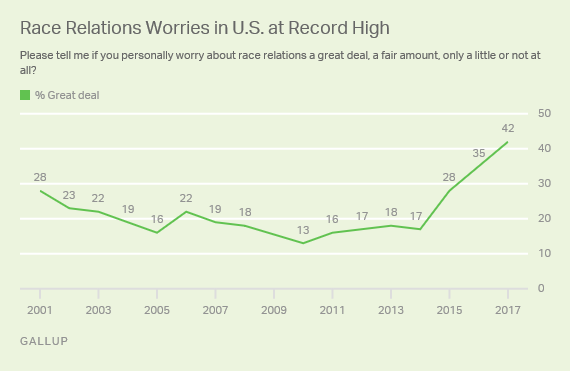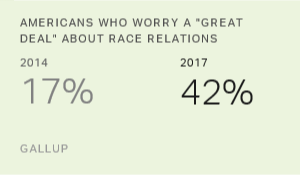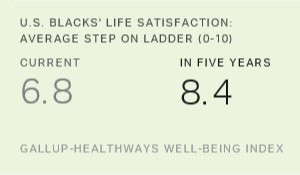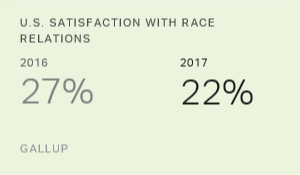Story Highlights
- 42% in U.S. worry a "great deal" about race relations
- Worries about this issue up from 17% in 2014
- 59% of Democrats, 29% of Republicans say they worry a "great deal"
WASHINGTON, D.C. -- Forty-two percent of Americans say they personally worry a "great deal" about race relations in the United States, up seven percentage points from 2016 and a record high in Gallup's 17-year trend. This is the third straight year worries about this issue have increased by a significant margin.

In 2010, early in Barack Obama's presidency, the percentage who expressed a "great deal" of worry about race relations hit an all-time low of 13%. This represented a continued decline in worry that began near the end of the George W. Bush presidency. The level of worry about this issue stayed in the teens until 2015.
Americans' worries about race relations have risen sharply over the past three years. In 2014, 17% said they worried a "great deal" about this issue; this climbed to 28% in 2015 and 35% in 2016.
This surge in worry about race relations likely stems from the racial tensions and public discourse sparked by high-profile incidents of police shooting unarmed black men and of black men shooting police in retaliation. Shootings in Dallas, Baton Rouge and Minnesota all occurred after Gallup last asked this question in March 2016.
The political success of President Donald Trump -- whose comments on racial matters, including his recent feud with Rep. John Lewis, have sparked outrage among some black leaders -- could also be a factor in Americans' heightened concern about race relations.
Democrats More Worried Than Independents, Republicans
Democrats' worries about race relations have risen by 33 percentage points over the past three years, now at 59%. Independents and Republicans are more worried now than they were in 2014, but their increases (26 points and 17 points, respectively) are smaller than that of Democrats.

Republicans' worries about race relations doubled between 2014 and 2015, from 12% to 26%, and have since leveled off at 29%. Democrats' worries about this issue have always exceeded Republicans', but the gap between parties is more sizable this year than it was in recent years.
Bottom Line
Race relations, one of the top concerns in the 1950s and 1960s, has returned as a major issue this decade. The Black Lives Matter movement sprang up in 2013 to combat allegedly racist police shootings and attracted national attention in 2014 after police shot an unarmed black teenager in Ferguson, Missouri. Movements such as Black Lives Matter have highlighted the precarious nature of black-white relations in the U.S.
Race relations or racism has emerged as one of the top issues on Gallup's most important problem list, rising from 1% to 3% of Americans mentioning the issue throughout much of 2014 to 18% doing so in July 2016 after incidents of violence between police and black men, making it the most important problem that month. Mentions of this issue have stayed at a monthly average of 9% since then.
Democrats remain more worried than Republicans about race relations, and Republicans' worries have not increased significantly this year, even after high-profile shootings by police and of police in 2016. Whether the overall amount of worry about this issue goes up or down in the coming year will likely depend on how many high-profile incidents occur and how Americans react to Trump's comments and actions related to race.
Historical data are available in Gallup Analytics.
Survey Methods
Results for this Gallup poll are based on telephone interviews conducted March 1-5, 2017, with a random sample of 1,018 adults, aged 18 and older, living in all 50 U.S. states and the District of Columbia. For results based on the total sample of national adults, the margin of sampling error is ±4 percentage points at the 95% confidence level. All reported margins of sampling error include computed design effects for weighting.
Each sample of national adults includes a minimum quota of 70% cellphone respondents and 30% landline respondents, with additional minimum quotas by time zone within region. Landline and cellular telephone numbers are selected using random-digit-dial methods.
View survey methodology, complete question responses and trends.
Learn more about how the Gallup Poll Social Series works.




